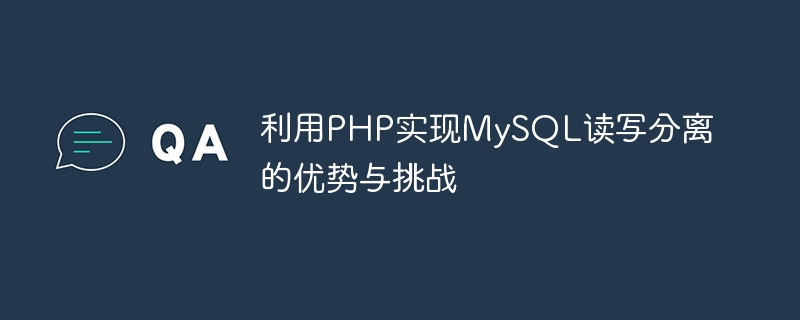Home >Backend Development >PHP Tutorial >Advantages and Challenges of Using PHP to Separate MySQL Read and Write
Advantages and Challenges of Using PHP to Separate MySQL Read and Write
- PHPzOriginal
- 2024-03-04 15:48:04728browse

Advantages and challenges of using PHP to implement MySQL read-write separation
As the scale of web applications continues to expand and the number of visits increases, Database read and write performance has become a key challenge faced by developers. In order to solve this problem, many developers began to use MySQL read-write separation technology to improve database processing capabilities. This article will explore how to use PHP to achieve MySQL read and write separation, while analyzing its advantages and challenges.
1. Advantages of MySQL read-write separation
- Load balancing: By allocating read operations and write operations to different database servers, it can be effectively Share the load on the database server and improve the overall performance of the system.
- Improve concurrency: Distribute read operations to multiple slave servers to handle more read requests at the same time and improve the concurrency of the system.
- Improve availability: When the primary database fails, the secondary database can take over the role of the primary database to ensure the normal operation of the system and improve the availability of the system.
2. PHP implements MySQL read-write separation
There are usually two ways to implement MySQL read-write separation in PHP: one is manual control, and the other is to use a third party Library.
1. Manual control
In PHP, you can connect to the MySQL database through extensions such as mysqli or PDO, and manually control the separation of reading and writing in the code. The following is a simple example:
// 主数据库写操作
$mysqli = new mysqli("主数据库地址", "用户名", "密码", "数据库名");
$mysqli->query("INSERT INTO table_name (column1, column2) VALUES ('value1', 'value2')");
// 从服务器读操作
$mysqli_read = new mysqli("从服务器地址", "用户名", "密码", "数据库名");
$result = $mysqli_read->query("SELECT * FROM table_name");2. Use third-party libraries
In order to more conveniently implement MySQL read and write separation, you can use some third-party libraries, such as Medoo, RedBeanPHP, etc. These class libraries provide more advanced database operation methods and simplify the implementation of read-write separation.
// 使用Medoo库连接数据库
require 'Medoo.php';
$database = new Medoo([
'database_type' => 'mysql',
'database_name' => 'database_name',
'server' => '从服务器地址',
'username' => '用户名',
'password' => '密码',
'charset' => 'utf8'
]);
// 读取数据
$data = $database->select("table_name", "*");3. Challenges and precautions
- Data consistency: Due to a certain delay in data synchronization between the master and slave servers, data reading may be delayed. In the case of inconsistency, developers need to handle this situation carefully.
- Connection pool management: Managing multiple database connections, especially the creation, release and timeout management of connections, requires reasonable design to prevent connection leaks or excessive consumption of resources.
- Troubleshooting: When the master server fails or the network is interrupted, it is necessary to switch to the slave server in time to ensure the normal operation of the system and give full consideration to the fault recovery mechanism.
Conclusion
MySQL read-write separation is an important technical means to improve database processing capabilities. Implementing read-write separation in PHP can effectively improve the performance and availability of the system. Developers need to fully understand its advantages and challenges, and rationally design and implement read-write separation solutions to meet the needs of different application scenarios.
Through the above introduction, I believe readers have a deeper understanding of the advantages and challenges of using PHP to achieve MySQL read-write separation. I hope it can help developers better apply this technology to optimize their own Web application.
The above is the detailed content of Advantages and Challenges of Using PHP to Separate MySQL Read and Write. For more information, please follow other related articles on the PHP Chinese website!

